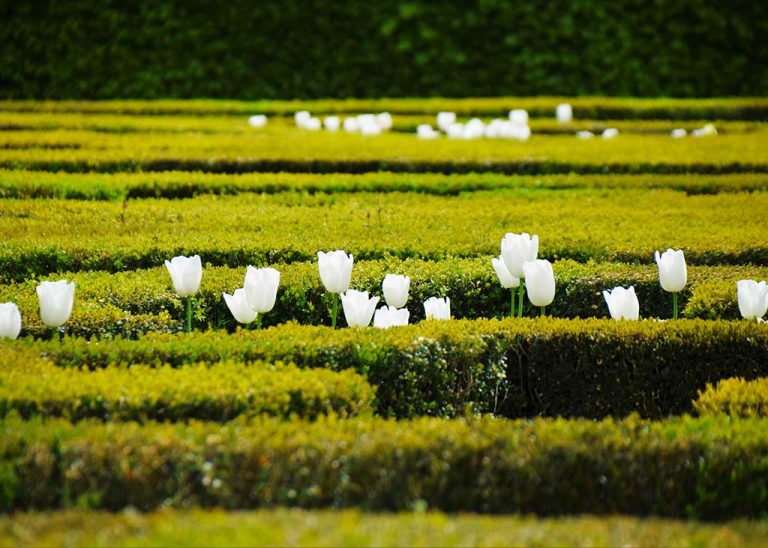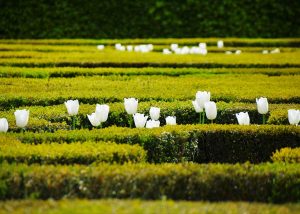The Orangery and the clementine trees of Villandry
In Villandry, when the clementine trees in planters are taken out of the Orangery and arranged in the parterre in the sun-drenched Jardins d’Amour, it means that spring has well and truly sprung. For thousands of years, citrus trees have been considered of great commercial value and provided rich inspiration for the imagination. Originating in sunny climes, they are a challenge for Northern gardeners, who must employ a great deal of inventiveness and expertise in order for them to adorn our gardens.

Clementine on the Parterre de l'Amour.
Citrus fruits are rare, precious and evocative
Evocative of the divine Garden of the Hesperides, reminiscent of the sweetly scented Moorish gardens discovered by crusaders, redolent of the Italian gardens visited during the Italian Wars, citrus trees convey the image of a golden age of abundant vegetation, luxuriating in a temperate and consistent climate. Citrus trees fascinate us with their colours, fragrances and flavours, and this is especially true for Northern Europeans, as they can only be grown in the ground from 45 degrees north of the equator, a line that runs along the north of Bordeaux and the south of Grenoble. In the 17th century, thanks to scientific advances in horticulture, it became possible to grow citrus beyond these climatic constraints. To combat the deadly effects of frost, citrus trees were grown in pots or planters. They were then put outside in beds and borders to soak up the summer sunshine, before being brought into an orangery at the first sign of winter weather, where they would spend the winter at a suitable ambient temperature. This hardening-off method lends citrus trees a symbolism of Man’s taming of Nature. This was taken to the extreme by André Le Nôtre, who successfully maintained an extraordinary outdoor orangery at the Trianon, using a system of glasshouses that could be dismantled. Owning citrus trees came at a significant cost, both in terms of the planters and the building of the orangery itself, and as such these plants were rare and precious.
Growing citrus at Villandry
There appear to have been citrus trees at Villandry since the 18th century, when the Marquis Michel-Ange de Castellane, Louis XV’s former ambassador to the Ottoman court, owned the estate. It may have been his nostalgia for Mediterranean gardens, or perhaps the effects of fashion, or a mixture of the two that led the Marquis de Castellane to have an orangery built at Villandry to house citrus trees.
The ideal place to display the citrus was the terrace – now the First Salon of the Ornamental Garden – which, as it was south-facing, enjoyed a great deal of sunshine, as well as sufficient shelter to protect the trees from the wind. The orangery was built nearby to facilitate the twice-yearly parade of the planters. Cut from the rock, standing five metres tall and covering a surface of 380 m2, the orangery was primarily a storage area, as well as acting as a buttress for the hill above it; meanwhile, the heat required to keep the trees healthy was guaranteed by the troglodytic construction of the building.
Seen from the outside, the orangery is identifiable by its traditional large French windows, which have several functions, including allowing the light to enter to warm up the air inside and promote photosynthesis and, when open, to ventilate the space and allow the heat to enter. As the Villandry orangery is troglodytic, making it somewhat dark, a lighting system was installed (updated in 2012) and is turned on for two hours a day to maintain the photosynthesis process.
The trees in planters spend an average of eight months a year outside and four months inside. As they suffer when overwintering, it is best to leave them outside for as long as possible. Together, the tree, the planter and the soil inside form a colossal weight to move. The planters were once transported on wagons pulled by animals, but are now handled by motorised vehicles that make the gardeners’ work a little easier. Throughout its life cycle, the tree is placed in a series of planters of increasing size, in line with the plant’s root growth. In addition to this repotting, the planters are opened up to change the soil, as it loses its nutrients after three or four years, as well as to plane the roots.
Take the advice of Villandry’s head gardener for growing your orange trees.
Bibliography:
J. de la Quintinie, Instructions pour les jardins avec un traité des Orangers, chap. 11 « Des différentes parties qui regardent la culture des Orangers », t. 1, 2de édition, Paris, Claude Barbin, 1697.
Louis Liger , Oeconomie générale de la campagne ou nouvelle maison rustique, 2de édition, t.2, Paris, Claude Prud’homme, 1768, p. 334 à 336.
Dictionnaire des sciences naturelles par plusieurs professeurs du Jardin du Roi et des principales écoles de Paris, Paris, F.G. Leurault, 1817, p. 297 à 332.
Virtual tour of the gardens of Villandry
Where will you go next?

























